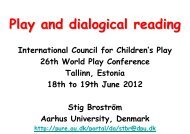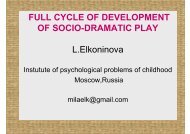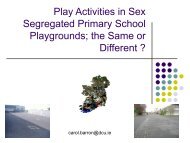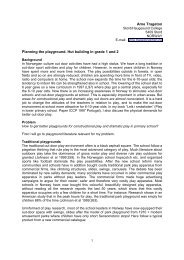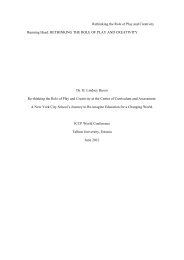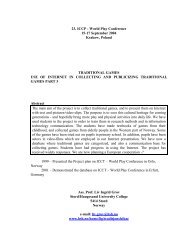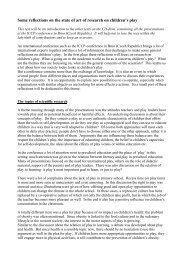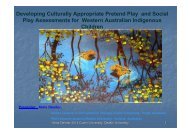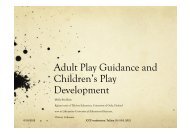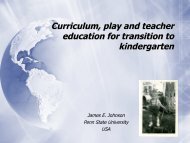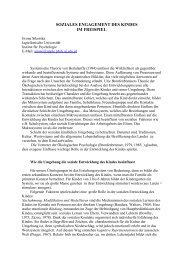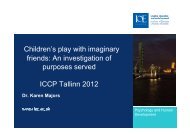Background - International Council for Children's Play
Background - International Council for Children's Play
Background - International Council for Children's Play
You also want an ePaper? Increase the reach of your titles
YUMPU automatically turns print PDFs into web optimized ePapers that Google loves.
Toril Hanssen<br />
Stord/Haugesund College<br />
Box 5000, 5409 Stord<br />
NORWAY<br />
e-mail: toril.hanssen@hsh.no<br />
Rough-and-tumble play among children six year-olds: Adult role.<br />
Abstract<br />
This presentation builds on previous work begun in 1997 when I studied play in three classes<br />
in lower primary school in Norway. Rough-and-tumble play had special interest with the<br />
research questions:<br />
What does rough-and-tumble (R&T) play mean to the children?<br />
In what ways do adults encourage rough-and-tumble play?<br />
I collected in<strong>for</strong>mation by using observations and interviews with the teachers. Data was<br />
analysed using phenomenological - hermeneutic method. Results include clear gender<br />
differences. Especially the boys chose R&T play and enjoy catching each other, play fighting,<br />
and challenging their strength and plasticity with each other. Results also showed that most<br />
teachers ignore or try to stop or <strong>for</strong>bid R&T play <strong>for</strong> several reasons: (1) Difficult to see this<br />
noisy activity as play; (2) The moral opinion;<br />
(3) Conflicts; (4) Fear <strong>for</strong> losing the control; (5) Fear <strong>for</strong> injuries; (6) Knowledge about the<br />
value of R&T <strong>for</strong> children’s social learning and <strong>for</strong> subjects in school<br />
Traditionally adults have not encouraged R&T play. My new work aims to increase<br />
knowledge about benefits of R&T play in order to change the attitude among the adults. Two<br />
classes in lower primary school are followed <strong>for</strong> an additional period of one year to cast<br />
further light on area of play and education.<br />
<strong>Background</strong><br />
Norway has got the most “playful” National Curriculum in Europe <strong>for</strong> the 6-10 year-olds<br />
(Trageton 1999). In the new school re<strong>for</strong>m (L97) play shall have a dominating place <strong>for</strong> the<br />
whole lower primary school (6-10 years). Lillemyr (1998:20 ) categorizes different play in this<br />
way:<br />
1) Sensomotoric play or functional play, especially existing the first two years of life<br />
2) Constructional play (experiments with objects, building with bricks and so on)<br />
3) Role play, which develops towards dramatic play<br />
4) Rule play (where the rules are central)<br />
5) <strong>Play</strong> with movements and rough-and-tumble play (especially among the 6 – 15 yearolds),<br />
often rooted in integration of senses and the need <strong>for</strong> motor activity<br />
In my study I observed all these categories of play among the six year-olds. After a while<br />
rough-and-tumble play (in the following just called R&T <strong>for</strong> short) became of special interest.<br />
This play was of very great present interest <strong>for</strong> the children. Besides, I did not find much<br />
literature about R&T. Through his categorization Lillemyr shows that movement and body is<br />
an important part of play <strong>for</strong> older children, as well. Besides, he places play with movements<br />
and R&T on the same foot. In most play literature R&T mainly appears as an under category<br />
of physical activity play (Johnsen, Christie & Yawkey 1999, Pellegrini & Smith 1998).<br />
In children’s play we can observe that the categories of play are not clearly separated from<br />
each other. In my study I wanted to categorize in a way that caught the most characteristic<br />
feature of the play. R&T can contain both movements, constructions, roles and rules, but the<br />
movement is the most prominent feature of the play.<br />
1
It is important to define R&T. Blurton Jones (1978) describes R&T through seven movement<br />
patterns. These are:<br />
“Running, chasing and fleeing; wrestling; jumping up and down with both feet<br />
together (“jumps”), beating at each other with an open hand without actually hitting<br />
(“open beat”); beating at each other with an object but not hitting; laughing. In<br />
addition, falling seems to be regular part of this behaviour, and if there is anything soft<br />
to land on children spend much time throwing themselves and each other on it”<br />
(Blurton Jones 1978:355).<br />
Rasmussen (1992) is inspired by Merleau-Ponty (Rasmussen 1996), the philosopher of the<br />
body, and has been talking about order and disorder in play. Order in play is characterised<br />
by a minimum of controversy and struggle. Disorder is characterised by confusion, joy,<br />
thoughtlessness, bodies in motion, display of power and intensity.<br />
Research questions<br />
1. What does rough-and-tumble (R&T) mean to the children?<br />
2. In what ways do adults encourage rough-and-tumble play?<br />
Methods<br />
I collected in<strong>for</strong>mation through field studies by using observations of the children’s play and<br />
the adult role. I spent ten days in each of the three classes with totally 59 children (a weak<br />
predominance of boys), four main teachers and two assistants. I interviewed the four main<br />
teachers. Data were analysed by using phenomenological – hermeneutic method.<br />
What does rough-and-tumble (R&T) mean to the children?<br />
Buytendijk (1933) is talking about the childlike behaviour which is characterised by (1)<br />
movement without a definite direction, (2) the need <strong>for</strong> movement, and (3) a playful attitude<br />
to what is happening here and now. According to R&T the children’s need <strong>for</strong> movement as<br />
we observe it in school, is of special interest.<br />
Buytendijk (1933) is also talking about amplitude in play. Amplitude means the distance<br />
between tension (disorder) and relaxation (order). In play the children must balance these<br />
points to each other. Too great tension will turn play into seriousness. Too great relaxation<br />
will destroy the play because it becomes boring and predictable.<br />
Merleau – Ponty (1962) is called the philosopher of the body. His theory stands in sharp<br />
contrast with the dualistic division between body and thinking/recognition. According to<br />
Merleau – Ponty it is through our bodies we are present in the world and come in contact<br />
with the things and the world. The children make experience through their senses. Without<br />
these experience they are not able to exist as reflected human beings. The body is the<br />
centre <strong>for</strong> all reflection. The body is our first instance of understanding. We must have<br />
experience to be able to understand, analyse and evaluate our experience. Our senses cooperate<br />
and communicate with each other. All the separate parts of the body stand in an<br />
inner relationship to each other.<br />
The body is not ruled by outside impulses alone. The body is intentional, seeking <strong>for</strong><br />
meaning. Our consciousness is always directed towards something. Merleau – Ponty<br />
emphasizes that human beings and society depend on each other. This is obvious in play.<br />
The children “read” each other’s bodies. In play communication cannot be regarded as a<br />
puzzle where statements and movements are translated from one area to another. Such a<br />
process will be too long-winded, and the play will be destroyed because it becomes slow and<br />
boring. The phenomenal body reads the intentions by those they are acting with and know<br />
how to respond in an adequate way.<br />
2
In the Norwegian National Curriculum, knowledge also includes social behaviour and<br />
practice. The physical movement combines acting and thinking (Duesund 1995). Practice<br />
and theoretical knowledge complete each other in movements. Activity occurs in the body<br />
and is mediated through the body. Theory is also developed from the body. The child must<br />
be able to understand and follow the rules. The child must think while acting. Knowledge<br />
about how to act demands a competent child because acting is bound to a context.<br />
Ayres (1989) emphasizes that a good integration of the senses is very important if the<br />
children shall be able to meet the <strong>for</strong>mal aims of knowledge in school. Each sense working<br />
optimal is not enough. The co-operation between the senses must also be satisfactory.<br />
According to Ayres the tactile system, the kinaesthetic system and the vestibular system is of<br />
especially great importance <strong>for</strong> children’s learning.<br />
The tactile system regards touch, deep pressure, pain, heat and cold.<br />
The kinaesthetic system includes all the sensory receptors in the muscles, tendons and<br />
joints, and give us in<strong>for</strong>mation about the position of the body.<br />
The vestibular system in the inner ear gives us in<strong>for</strong>mation about the position of the head.<br />
This in<strong>for</strong>mation helps to maintain static and dynamic balance. The vestibular system is the<br />
most important structure in the regulation of body postures. It prevents falling and contributes<br />
to graceful, coordinated movements.<br />
Ayres maintains that many of the problems with learning in school are due to these three<br />
systems and the cooperation between them. These important senses are trained in R&T. In<br />
such a view R&T can have a preventive function in a society characterized by lower physical<br />
activity. In addition this will be done in an attractive way because the sign of play is “intrinsic<br />
motivation”, “suspension of reality” and “internal locus of control” (Levy 1978).<br />
Rough-and-tumble play. Adult roles.<br />
In order to maximise the positive results of play <strong>for</strong> children’s development and learning, the<br />
adults have to take an active role in order to give children rich and varied play experience. In<br />
this work there are three basic steps: (1) Providing resources <strong>for</strong> play (2) Observing play (3)<br />
Becoming supportively and responsively involved in play (Johnson, Christie & Yawkey<br />
1999:204). This time my attention is concentrated on the adult role in the direct meeting with<br />
R&T. Adult involvement in play is a controversial question. Johnson, Christie and Yawkey<br />
(1999:190) refer to research on adult involvement in play. They conclude in this way:<br />
“Our position is that adult involvement can have both positive and negative effects on<br />
play. The crucial variable is how adults become involved in play. If adults interact with<br />
children in a sensitive, responsive, and supporting manner, they can enhance<br />
children’s play. On the other hand, if adults take over control of play, provide too<br />
much structure, or interrupt play <strong>for</strong> academic purposes, children’s play will probably<br />
suffer” (Johnson, Christie and Yawkey 1999:217).<br />
As most play theorists Johnson, Christie & Yawkey write about the adult role mainly in<br />
sosiodramatic play; but how adults become involved in play is also a crucial variable to<br />
children in R&T.<br />
A series of recent descriptive researches have given us knowledge about positive and<br />
negative effects on play. Adult roles can be collected in this categorical system: uninvolved,<br />
onlooker, stage manager, co player, play leader and director/instructor (Johnson, Christie &<br />
Yawkey 1999:209). These adult roles must be seen along a continuum from no<br />
involvement/interest on the one side to complete control on the other. The extreme roles as<br />
uninvolved and director/instructor tend to have negative effects on children’s play<br />
experience. The adult roles as onlooker, stage manager, co player and play leader are<br />
considered to be the most productive roles.<br />
3
The uninvolved: pay no attention to play and only act as security and intervene just when<br />
obvious conflicts and danger occur, or when the play gets loud and noisy.<br />
The onlooker serve as an active audience <strong>for</strong> the children’s play and show their interest and<br />
accept through non-verbal signs and verbal comments to the players.<br />
The stage manager does not enter the play, but takes a more active role to help the children<br />
to prepare their play and to offer assistance when the play has started.<br />
The co player becomes an active and equal participant in children’s play.<br />
The play leader is a more active participant in children’s play than the co player. The play<br />
leader takes more influence in order to enrich and extend ongoing play.<br />
The director/instructor takes control of the play and tells the children how to play.<br />
Which of the roles that appears to be the best one, must be considered in connection with<br />
the actual situation, the child and the group. Through observations of children’s play the<br />
teacher continuously must evaluate which of the adult roles that seem to be the best one in<br />
order to enhance and support play.<br />
Results<br />
I have chosen a few examples from my field notes to illustrate my findings. The glimpses are<br />
taken from written observations and transcripts from the interviews.<br />
Class one<br />
The children were very inventive to use all opportunities <strong>for</strong> R&T. The boys especially<br />
enjoyed catching each other, play fighting and wrestling:<br />
“Two boys are wrestling with each other – a large nine year old boy and a little six<br />
year old boy. The oldest one gives resistance, but treats the younger one with care<br />
(…) I tell I am impressed of the way the older one is adapting his strength to the<br />
younger one. He gives me a smile and says that the youngest one was allowed to<br />
wrestle as hard as he could manage, but he himself did not have this opportunity<br />
because he was the strongest one. There<strong>for</strong>e he just used one hand!”<br />
There were no adults present during the play presented above, and I decided to take the role<br />
as an onlooker. In this class R&T was left alone to the children. The main teacher played the<br />
role as uninvolved. The main teacher said about R&T play:<br />
“(…) Close contact I think is important to the children. They get an opportunity to use<br />
and to try their strength. But I must say I have little experience with this type of play<br />
(…) I am afraid it easily can become serious (…) The first times I thought the fighting<br />
was real when I found them rolling on the ground (…) This play demands an adult<br />
being present. And we do not have too many of them, so I find this to be a bit difficult<br />
(…)”.<br />
The main teacher, who chose an active role in other types of play, took the role as an<br />
uninvolved in R&T. Her resistance was obvious. The children got no help to understand how<br />
to avoid conflicts and how to maintain the play. She tried to stop them when obvious conflicts<br />
occurred, and when the play got loud and noisy.<br />
Class two:<br />
R&T was of great importance in this class too – not only <strong>for</strong> the boys, but also <strong>for</strong> many of the<br />
girls. At this time wrestling matches were of special interest:<br />
“In the schoolyard six of the children start to play R&T. They throw each other on the<br />
ground. Two of them are girls. The main teacher participates in the play. She accepts<br />
to be thrown on the ground by the children”.<br />
Five children are active in a wrestling match:<br />
4
“(…) But the play can be conflicted. The group can easily become so big that the<br />
children do not manage to administrate their own play. Pushes and strikes occur and<br />
lead to crying, Another teacher who is together with the class at the time, starts a<br />
discussion with the main teacher. She wants to <strong>for</strong>bid the play (…)”.<br />
In R&T the main teacher surveyed the situation and chose roles which were positive<br />
according to the actual situation. She avoided acting as an uninvolved. According to the<br />
situation she acted both as an onlooker, a stage manager, a co player, a play leader – and<br />
as an instructor. As an onlooker she showed her interest and support through non-verbal<br />
signs and verbal comments. As a stage manager she helped the children to prepare their<br />
play and offered assistance when the play had started. As a co player and a play leader she<br />
took an active part in play where the children took lead most of the time. She gave indirect<br />
guidance. The children could observe her behaviour, in what way she took care <strong>for</strong> her<br />
playmates, how she used her strength and so on. She gave concrete examples according to<br />
how the children themselves could act. In some situations she also took the role as an<br />
instructor in a positive way. In fighting play and wrestling matches she told the children that<br />
two playmates at the moment were enough. Besides, they had to make the rules clear be<strong>for</strong>e<br />
starting, and the play had to come to an end when one of the playmates said: Stop!<br />
With respect and care I think the instructor role can be of great value in R&T where the<br />
children are in so close contact with each other. R&T separates from dramatic play and must<br />
perhaps be evaluated a bit differently. In this class the adult role as an instructor in a positive<br />
way helped the children to maintain the play with joy and few conflicts.<br />
Class three<br />
Once a week this class used to spend the whole day at “their own place” in the <strong>for</strong>est. This<br />
place lay about 15 minutes walk from the school. This area had a hilly ground with small<br />
mountains, trees and paths. R&T was most obvious when they were in the <strong>for</strong>est, but I also<br />
recognised this play in the schoolyard among the boys.<br />
The boys were especially interested in playing “Sinbad the Sailor”; “Turtles” and “Dinosaurs”.<br />
In this glimpse they are playing “Turtles”:<br />
“(…) They do a united front against the others, coming creeping down the path. The<br />
two groups run around, fence and shoot at each other. My focus is directed towards<br />
two of the boys. They are fencing with sticks. I am impressed by how perfect they<br />
harmonise their movements to each other, how they can hit each other without doing<br />
any harm. The movements are accompanied with sounds which are perfectly timed to<br />
the movements”.<br />
Two teachers were sharing the job as main teacher in this class. Both took the role as<br />
onlookers in children’s play. The interviews showed that this was a conscious choice. They<br />
did not want to disturb or direct children’s play. However, they surveyed the play and helped<br />
the children to solve problems. These children are playing “Dinosaurs”:<br />
“(…) A new challenge occurs. Two of the playmates begin to fight seriously. Main<br />
teacher 1 recognises this at once and is coming in order to guide and mediate. They<br />
discuss roles and how to develop the play in a democratic way (…) She finishes by<br />
asking: Are you able to go on playing now? They are, and the play is intense and<br />
living until they have to go back to school 25 minutes later”.<br />
“(…) “Sinbad the Sailor” is the theme of the play, but they disagree on how to<br />
distribute the roles and how to develop the play. They begin to throw pieces of wood<br />
towards each other. Main teacher 2 takes place on a rock together with the children<br />
and guides them to chose another play. They agree and start to play hide-and-seek”.<br />
5
Main teacher 2 did not help the children to continue their play, but guided them to chose<br />
another play. In the interview she said:<br />
“I do not like war games (…) I do not like weapons because it often ends with crying.<br />
When they play “Dinosaurs” they have the same opportunity to use their strength,<br />
close contacts, but it more seldom ends with crying. But if they play war there is<br />
always a stone or a stick (…) that becomes a weapon, and I do not like it”<br />
Main teacher 2 expressed directly that she saw the value of R&T, except <strong>for</strong> war games with<br />
stones and sticks as weapons. The starting point to main teacher 1 was a bit different. She<br />
saw the value in playing “Turtles” and “Sinbad the Sailor” – games closely connected with<br />
war games:<br />
“ (…) I am impressed by the way they manage to start the play, how they manage to<br />
rule it, their general view, and how they change between being inside and outside the<br />
play, how they use the spoken language in play (…)”.<br />
Main teacher 1 saw the parallels between this play and positive experience from her own<br />
childhood when she was playing “Robin Hood” with her playmates. To her it was important to<br />
act as a more competent other (Vygotsky 1978) in order to make them able to maintain and<br />
develop their own play with joy and few conflicts.<br />
Discussion<br />
Smith and Boulton (1987) suggest that R&T may take up something like 10% of children’s<br />
play, but that there will be considerable variations according to gender, age and playground<br />
surface and so on. In my study it was difficult to measure R&T in per cent because the play<br />
<strong>for</strong>ms to a large extent overlapped each other (the danger of errors). However, I will estimate<br />
R&T to take up at least 20% of the children’s play as I observed it during thirty days in my<br />
field studies.<br />
According to the adult role in R&T the four main teachers all expressed they saw the value<br />
in R&T, but practise showed that this was understood in different ways and resulted in<br />
different practice. Just one of the main teachers took an active part in R&T, and just two of<br />
them guided the play in a manner that made the children able to maintain and develop their<br />
play. One of the classes in my research spent one day a week outside the school on “their<br />
place” in the <strong>for</strong>est. Observing the main teachers in this class gave interesting in<strong>for</strong>mation.<br />
R&T in the schoolyard was met with little interest. Here the adults took the role of the<br />
uninvolved. In the <strong>for</strong>est the picture of their practice in play became more complete. None of<br />
them took an active part in the play as a co player or a play leaders, a practice the interviews<br />
showed depended on a conscious choice and referred to all kinds of children’s play. But both<br />
acted as onlookers. Besides, one of them acted as a stage manager.<br />
My main conclusion is that there are great attitudinal differences among the adults, but that<br />
R&T is not accepted in the same way as other parts of play with movements, constructional<br />
play, role play and rule play. However, this was more obvious when the focus was directed<br />
towards the two assistants and the other teachers acting in the schoolyard. Most teachers<br />
tried to stop R&T, <strong>for</strong>bid it or ignore it <strong>for</strong> several reasons. Main teacher in class two<br />
expresses:<br />
“(…) You see what is happening? When the children have fighting play, wrestling<br />
matches or are rolling on the ground, the other teachers just turn their back on it.<br />
They have either initiated the play or allowed it. There<strong>for</strong> they take no responsibility. I<br />
feel their criticism <strong>for</strong> allowing this play and <strong>for</strong> taking an active part in it”.<br />
R&T as play<br />
Rasmussen (1992) says that the mental side of play has been focused in literature. The<br />
result is that the body and the movement as important parts of play has been pushed into the<br />
shadow. Besides, it may be difficult <strong>for</strong> adults to identify themselves to the childlike<br />
6
demonstration of body and movement. This makes us less capable to understand how<br />
important and valuable R&T is from the children’s point of view.<br />
Often R&T is not understood as play, but as conflicts and real fighting. Main teacher in class<br />
one expresses this when she says that the first times she found children rolling on the<br />
ground, she thought this happened outside the frame of play (among others: Schwartzman<br />
1978) . Such an interpretation will easily lead to an adult role of no advantage <strong>for</strong> children<br />
and R&T.<br />
The moral opinion<br />
None of the main teachers directly expressed they had a moral resistance towards R&T, an<br />
opinion not to bring children up to fighting, violence and war. Although, through my own<br />
practice in school, I think this is an important point when resistance towards R&T is tried to<br />
be understood. Mouritsen, researcher on children’s culture, maintains that disorder in play<br />
challenges our moral opinion. Mouritsen (1996) and Olofsson (1990) both emphasize that<br />
children are more competent to distinguish between what is play and what is reality than<br />
many of the adults.<br />
Mouritsen brings up another aspect. He is talking about R&T as an important part of<br />
children’s culture and the aesthetic characteristics in this play. That is the way in which the<br />
children adapt their movements to each other, their artistic jumps and hits and sounds which<br />
are perfectly timed to the situation. These aesthetic characteristics were exactly what<br />
impressed me when the boys fought against each other as “Turtles” in the <strong>for</strong>est. If teachers<br />
turn their back to this play, they will neither get in<strong>for</strong>mation about this play nor become aware<br />
of the qualities in it.<br />
Conflicts<br />
One of the main teachers do not like war play because it so often ends with conflicts and<br />
crying. Conflicts in R&T are usually more obvious, but not necessarily more serious than<br />
conflicts in other types of play. Åm (1989) observed how children in some situations could<br />
hurt each others feelings without the adults being aware of it. Reflecting to this I think most of<br />
us will not consider small physical accidents as more serious than quiet conflicts hurting the<br />
children’s feelings.<br />
Fear <strong>for</strong> losing control<br />
None of the main teachers directly expressed that R&T created a feeling of chaos to them.<br />
Fischer and Madsen (1990) have made a research in Danish kindergartens where the focus<br />
is directed against the adult’s feeling of chaos. Fischer and Madsen do not connect this<br />
feeling directly to R&T, but to situations where the adults generally have the feeling of losing<br />
control. What mainly caused this feeling was increasing noise. Noise was defined as<br />
something negative and not as an expression <strong>for</strong> something. This shows how important it is<br />
to take the children’s point of view, to interpret their signals and to look <strong>for</strong> what is happening<br />
in R&T.<br />
Fear <strong>for</strong> injuries<br />
In Norway we can notice an increasing knowledge of the importance of play with movements<br />
generally. At the same time we have a discussion about safety. Safety is to be taken<br />
seriously, but at the same time pedagogues have a responsibility to create a stimulating<br />
environment which gives challenges, positive tension and possibilities <strong>for</strong> the children.<br />
Injuries probably arise to a larger degree when the teachers do not pay attention to the play<br />
and give necessary support and guidance (Trageton 1997). We saw how one of the main<br />
teacher acted more competent (Vygotsky 1978) towards R&T in class two. She gave them<br />
ways to administer and develop their play in order to avoid conflicts and injuries.<br />
As mentioned earlier, the two main teachers in class three ignored R&T in the schoolyard. In<br />
the <strong>for</strong>est both main teachers acted as onlookers. One of them acted as a stage manager, as<br />
7
well. “Their own place” in the <strong>for</strong>est was with its hilly ground, small mountains, trees and<br />
paths perfectly suited <strong>for</strong> R&T. Perhaps R&T in the <strong>for</strong>est by the adults were regarded as<br />
less dangerous. The children had more space and the playground surface was more<br />
suitable.<br />
Knowledge about the value of R&T <strong>for</strong> development and learning<br />
Pedagogical practise will always be a picture of our knowledge, our values and what we find<br />
important to emphasize in our work with children. All the main teachers expressed they saw<br />
the value and importance of R&T <strong>for</strong> the children, but variable practises showed that this was<br />
understood in different ways. Knowledge about R&T as a contribution to social development<br />
was expressed by two of the four main teachers. However, most teachers in my field studies<br />
found it difficult to see R&T as a playful training of social competence. Besides, none of the<br />
main teachers expressed that R&T was a contribution to <strong>for</strong>mal aims of knowledge in school.<br />
According to my experience we neither have good enough knowledge about the body as the<br />
centre <strong>for</strong> reflection nor of the importance of the three basic senses and the co-operation<br />
between them.<br />
Conclusion<br />
My main conclusion is that there are great attitudinal differences among the adults. For<br />
several reasons R&T is not accepted in the same way as other parts of play with<br />
movements, constructional play, role play and rule play. Few days ago I went into the<br />
database OCLC FIRST SEARCH to see how many hits I could find about R&T compared<br />
with other play categories:<br />
<strong>Play</strong> category WorldCat ECO ArticleFirst<br />
Motor play 610 90 30<br />
R&T 7 2 10<br />
Object play 220 60 30<br />
Constructive play 60 20 4<br />
Dramatic play 2300 80 60<br />
Role play 15000 3900 3300<br />
Rule play 270 50 30<br />
WorldCat<br />
ECO<br />
ArticleFirst<br />
OCLC catalog of books, web rescourses, and other material worldwide<br />
An OCLC collection of scholarly journals (Browse Journal Titles)<br />
An OCLC index of article<br />
Very few R&T – hits shows that this play is not a primary field of research. From my point of<br />
view, R&T has so far been neglected in literature. I hope this will change.<br />
Through his categorization Lillemyr (1998) shows that movement and body is an important<br />
part of play <strong>for</strong> older children, as well. He places play with movements and R&T on the same<br />
foot. I think it is useful to categorise R&T as a separate play category and not a subcategory<br />
of physical play as we find it in most play literature.<br />
I hope a more widespread research will increase our knowledge about the benefits of R&T.<br />
We as pedagogues have to see the differences between R&T and real fighting. We have to<br />
understand that R&T is a contribution to social development. In this play children both have<br />
to take care of their playmates and have the possibility to increase their social competence.<br />
As pedagogues we also have to understand in what way R&T is a contribution to learning<br />
subjects in school.<br />
8
I still have many questions about R&T. My new work aims to increase knowledge about<br />
benefits of R&T play in order to change the attitude among the adults. Two classes in lower<br />
primary school are followed <strong>for</strong> an additional period of one year to cast further light on area of<br />
play and education.<br />
References<br />
Ayres, J. A. (1989):<br />
Sanseintegration hos børn. København: Munksgaard<br />
(Sensory integration and the child)<br />
Blurton Jones, N. (1967): “Rough-and-tumble <strong>Play</strong> among Nursery School<br />
Children”. In Bruner, J. S. & Jolly, A. & Sylvia, K. (ed)<br />
<strong>Play</strong> – Its role in Development and Evolution. New York:<br />
Penguin Books 1979. 352-264.<br />
Buytendijk, F. j. J. 81933):<br />
Wesen und Sinn des Spiels. Berlin: Kurt Wolf<br />
Duesund, L. (1995): Kropp, kunnskap og selvoppfatning. Oslo:<br />
Universitets<strong>for</strong>laget<br />
(Body, knowledge and self understanding)<br />
Fischer, U. & Madsen, B. L. (1990): Se hær! En bog om børns opmærksomhed. København:<br />
Forlaget Børn og Unge<br />
(Look here - About Children’s attention).<br />
Johnson, J. E., Christie, J. F.<br />
& Yawkey, T. D. (1999):<br />
Levy, J. (1978):<br />
Lillemyr, O. F. (1998):<br />
Merleau-Ponty, M. (1962):<br />
Mouritsen, F. (1996):<br />
Olofsson, B. K. (1990):<br />
<strong>Play</strong> and Early Childhood Development. New York:<br />
Longman<br />
<strong>Play</strong> Behaviour. New York: J. Wiley & Sons. Inc.<br />
Varierte <strong>for</strong>mer <strong>for</strong> lek og læring. Et veiledningshefte.<br />
Trondheim: Dronning Mauds Minne, Høgskole <strong>for</strong><br />
førskolelærerutdanning.<br />
(Varied Forms <strong>for</strong> <strong>Play</strong> and Learning)<br />
Phenomenology of perception. London: Routledge &<br />
Kegan Paul<br />
Legekultur. Essays om børnekultur, leg og <strong>for</strong>tælling.<br />
Odense: Odense Universitets<strong>for</strong>lag<br />
(The Culture of <strong>Play</strong>. Essays)<br />
Leg <strong>for</strong> livet. København: Forlaget Børn & Unge<br />
(<strong>Play</strong> <strong>for</strong> Life).<br />
Pellegrini, A. D. &<br />
Physical Activity <strong>Play</strong>: The Nature and Function of a<br />
Smith, P. K. (1998): Neglected Aspect of <strong>Play</strong>. Child Development (?)<br />
Rasmussen, T. H. (1996):<br />
Rasmussen, T. H. (1992):<br />
Kroppens filosofi. Brøndtby: Semi-<strong>for</strong>laget<br />
(The Philosopher of the Body)<br />
Orden og kaos. Elementære grundkræfter i leg.<br />
Brøndtby: Semi-<strong>for</strong>laget<br />
(Order and Disorder in <strong>Play</strong>).<br />
9
Schwartzman, H. (1978):<br />
Trans<strong>for</strong>mation, an Antropology of Childrens <strong>Play</strong>. New<br />
York: Plenum Press<br />
Smith, P. K. & Boulton, M. (1987): “How rough is Rough and Tumble?” SET research<br />
in<strong>for</strong>mation <strong>for</strong> teachers. Article number 1/1987.<br />
Trageton, A. (1999):<br />
Trageton, A. (1997):<br />
Vygotsky, L. S. (1978):<br />
<strong>Play</strong> in Lower Primary School in Norway. Santa Fe,<br />
Mexico: TASP Conference<br />
Leik i småskolen. Oslo: Universitets<strong>for</strong>laget<br />
(<strong>Play</strong> in Primary School).<br />
Mind in Society. Cambridge, Massachusetts: Harvard<br />
University. 79-105.<br />
Åm, E. (1989): På jakt etter barneperspektivet. Oslo:<br />
Universitets<strong>for</strong>laget<br />
(Hunting <strong>for</strong> the children’s point of view)<br />
10



